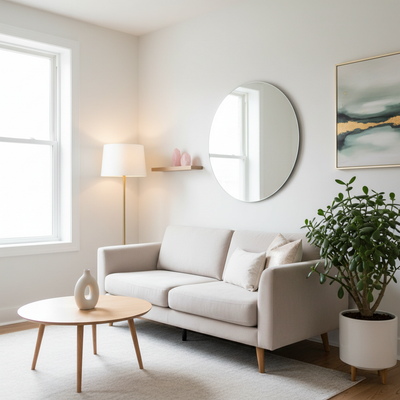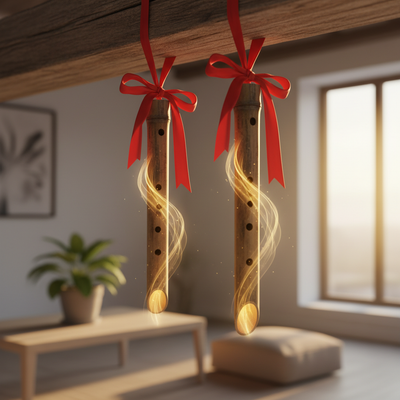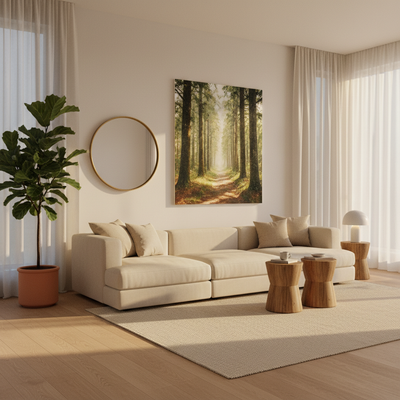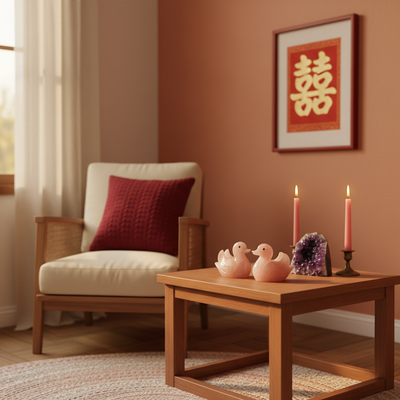Introduction: Seeing the Hidden Possibilities

People often ask us: are attic bedrooms bad for feng shui? Many think they are difficult spaces, and they have good reasons for this. The special design of an attic—with its slanted ceilings and visible beams—can create energy problems that regular rooms don't have. However, we want to change the story of the "problem attic."
Think of your attic not as a space with built-in problems, but as a space with special character. With the right knowledge and steps, these design quirks can be changed. The very features that create challenges can be used to create a safe space that is extra cozy, protective, and peaceful. This guide is your complete roadmap. We will help you understand the main energy issues, make basic changes like bed placement, and use specific fixes to turn your feng shui attic bedroom from a source of worry into a place of healing energy.
Understanding Main Challenges
To successfully transform your attic, you must first understand the energy rules at work. The design of an attic naturally creates specific patterns of Qi (life force energy) flow that can affect well-being. By finding these issues in your own space, the solutions that follow become more focused and powerful. Here are the main feng shui challenges presented by attic bedrooms.
The Pressure of Slanted Ceilings
Angled ceilings create a form of energy squeezing. Imagine Qi as water flowing through a room; a low, angled ceiling can feel like a constant, gentle pressure pushing down on the people inside. This can hold back the natural upward flow of personal energy, leading to feelings of being held back, a lack of inspiration, or even restless sleep. When you spend eight hours a night under this squeezing force, it can quietly affect your subconscious, impacting your mood and energy during your waking hours.
The Problem of Visible Beams
Overhead beams are a more aggressive energy feature. In feng shui, these are considered a source of "Sha Qi" or "cutting energy." A heavy beam directly over your bed can feel like a knife, symbolically dividing the energy of the people sleeping beneath it. This can show up as health issues in the part of the body directly under the beam, feelings of being under pressure at work or in life, or even create a sense of division between partners sharing the bed. The weight and sharp line of the beam disrupt the smooth, nourishing circulation of Qi essential for a restful environment.
The Mess of Uneven Shapes
Most attics are not perfect squares or rectangles. They often have unusual angles, corners, and dormer windows that create an uneven floor plan. While visually interesting, these shapes can cause Qi to either get stuck in forgotten corners or move wildly, creating a sense of imbalance. A balanced, even room promotes a feeling of stability and calm. In an unevenly shaped attic, energy can get "stuck," leading to a feeling of being stuck in certain areas of your life, or it can bounce around wildly, contributing to mental mess and restlessness.
The Problem of Access and Energy
The journey of Qi into your bedroom is as important as the energy within it. Attics are often reached by steep, narrow staircases. This can cause energy to rush up into the space too forcefully, creating an unsettled feeling. On the other hand, a poorly lit or cramped entryway can make it difficult for fresh, positive Qi to climb and feed the room, leaving the space feeling isolated and drained. The transition into your safe space should be graceful, allowing energy to flow in a gentle, winding way.
Foundation of Peace: Bed Placement
Of all the adjustments you can make, the placement of your bed is the single most impactful action for improving the feng shui of your attic bedroom. The bed is where you spend a third of your life in a passive, receiving state. Its position determines how safe, supported, and in control you feel, directly influencing your quality of sleep and overall well-being.
Finding Your Power Spot
In feng shui, the ideal bed placement is known as the "Commanding Position." This means you can see the door to the room from your bed without being directly in line with it. This position gives your subconscious a sense of security and control, as you can see who or what is entering your space.
In an attic, adapting this rule is key. The best location for your bed is with the headboard against the tallest, most solid straight wall in the room. This provides the strongest sense of backing and support, fighting against the downward pressure of the sloped ceilings. From this position, you should ideally have a clear, diagonal view of the bedroom door. This combination of solid support behind you and a clear view before you is the ultimate power spot in any bedroom, especially an attic.
Practical Alternatives
The ideal layout isn't always possible. Attics are known for their design limits. If you cannot place your bed against the tallest wall, here are the next best options, guided by a clear set of dos and don'ts.
| Placement Action | Feng Shui Reasoning |
|---|---|
| DO: Use a strong, solid headboard. | A substantial headboard acts as a symbolic mountain, providing support and protection, especially when a solid wall is not an option. |
| DO: Place the bed so your feet point toward the lower side if you must be under a slope. | This is a compromise. It prevents the oppressive energy of the low ceiling from pressing directly down on your head, which is more disruptive to sleep and mental clarity. |
| DO: Ensure you can see the door. | If you cannot achieve the classic commanding position, use a small, freestanding mirror placed on a dresser to reflect the door, giving you a view without having it directly face your bed. |
| DON'T: Place your head directly under the lowest point of the slope. | This is the most oppressive position, creating constant energy pressure on your head and crown chakra, which can lead to headaches, anxiety, and poor sleep. |
| DON'T: Place the bed directly under a heavy overhead beam. | Avoid this at all costs. The "cutting energy" from the beam can disrupt your energy field, potentially leading to health issues and relationship problems. |

| DON'T: Align the bed directly with the door ("coffin position"). | Energy rushes directly at the bed, creating a feeling of being startled and preventing deep, restorative rest. |
Activating Positive Qi: Your Toolkit
With your bed in the best possible position, the next step is to actively manage and enhance the Qi in your feng shui attic bedroom. This involves using specific "cures"—feng shui adjustments that neutralize negative energies and grow a positive, life-affirming environment. This toolkit provides practical, actionable solutions for each of the core attic challenges.
Neutralizing Sloped Ceilings
The main goal here is to visually and energetically "lift" the ceiling to fight against its oppressive weight.
-
Paint it Up: The simplest and most effective cure is paint. By painting the sloped ceilings and all the walls the same light, uniform color, you blur the lines where the walls end and the ceiling begins. This creates an optical illusion of a larger, more open space. Choose colors like soft white, light beige, or a pale sky blue. Color psychology research supports this; lighter shades are perceived by the brain as less heavy and more expansive, which can reduce feelings of being trapped and elevate mood. The uniform color allows Qi to flow smoothly without being "chopped" by jarring transitions.
-
Uplighting: Direct light upwards. The downward pressure of a sloped ceiling can be energetically fought by an upward flow of light. Use floor lamps (torcheres) tucked into corners or wall sconces that cast their glow onto the ceiling. This technique not only brightens the room but also creates a powerful energetic "lift," making the ceiling feel higher and the entire space feel more expansive and less oppressive.
Curing and Concealing Beams
The "cutting Sha Qi" from exposed beams, especially over a bed, must be addressed.
-
Fabric Canopy: The softest and most romantic cure is to create a fabric canopy. Draping a large piece of light, flowing fabric (like cotton, linen, or chiffon) from the ceiling to hide the beam completely diffuses its sharp, cutting energy. This creates a soft, protective cocoon over the bed, transforming the beam from a threat into the anchor for a beautiful design feature.
-
Paint the Beam: If a canopy isn't your style, a more simple cure is to paint the beam the exact same color as the ceiling. This helps the beam visually disappear, reducing its energy impact. While it doesn't eliminate the Sha Qi entirely, it significantly lessens its oppressive presence by making it less of a focal point.
-
Bamboo Flutes: A traditional feng shui cure involves hanging two hollow bamboo flutes on the beam. They should be hung with red ribbon or cord, with the mouthpieces pointing up, forming an A-frame shape. The flutes are believed to lift the heavy, downward-pressing energy of the beam and transform it.
Using Light and Space
Light is a form of Qi. In a potentially dark and cramped attic, managing light is critical.
-
Layer Your Lighting: Relying on a single overhead fixture can create harsh shadows and make the space feel smaller. Instead, layer your lighting. Start with ambient light from your uplighting fixtures. Add task lighting with stylish bedside lamps for reading. Finally, consider accent lighting, like a small picture light over a piece of art, to create pools of interest and depth.
-
The Careful Use of Mirrors: Mirrors can be powerful tools for expanding a space and amplifying light, but they must be used with care in a bedroom. A mirror should never, ever reflect the bed. This is believed to invite a third party into the relationship and can disrupt your own energy while you sleep, causing restlessness. The best placement for a mirror in a feng shui attic bedroom is on a wall where it can reflect a window, effectively doubling the amount of natural light and scenery you bring into the room.
Grounding the Energy
The top-heavy feeling of an attic with sloped ceilings needs to be balanced with strong, grounding energy below.
-
Rugs and Flooring: Anchor the room with a substantial area rug. A thick, heavy rug in earthy tones (like terracotta, sand, or deep brown) provides a powerful grounding effect. It defines the space and adds a layer of stability, making the entire room feel more secure and settled.
-
Low, Heavy Furniture: Balance the low ceilings with low-profile, solid furniture. Choose a dresser, nightstands, and benches that are wide and heavy rather than tall and thin. This type of furniture adds visual and energy weight to the lower half of the room, creating a sense of stability that makes the sloped ceilings feel less imposing.
A Real-World Transformation
Theory is valuable, but seeing it in practice provides true clarity. At THE QI FLOW, we frequently guide clients through the process of transforming their challenging spaces. A recent case perfectly shows the power of these principles.
The Client's Challenge
Our client, Sarah, had recently moved into a new home and converted the charming but architecturally complex attic into her master bedroom. While she loved the look, she found herself struggling with restless nights, waking up frequently, and feeling a persistent, low-grade anxiety she couldn't shake. Her layout was a classic attic "mistake": to maximize floor space, she had pushed her bed with its low headboard against the wall with the lowest slope. To make matters worse, a beautiful but massive, dark-stained wooden beam ran directly across the middle of the bed.
Our Team's Diagnosis
During our virtual consultation, THE QI FLOW team immediately identified the energy stressors. Sarah was sleeping in a position of extreme vulnerability. The low, slanting ceiling directly over her head was creating constant energy pressure on her crown, a primary cause of her anxiety and restless mind. At the same time, the heavy beam was generating powerful "cutting Sha Qi" right over her body, disrupting her energy field and preventing deep, restorative sleep. She was, in essence, being energetically "pressed" and "cut" for eight hours every night.
The Step-by-Step Solution
We provided Sarah with a clear, three-step action plan focused on maximum impact with minimal cost.
-
Reposition the Bed: This was the non-negotiable first step. We had her move the bed across the room, placing her existing headboard against the highest vertical wall. This single move immediately took her out from under both the lowest part of the slope and the direct path of the beam, placing her in the commanding position with a view of the door.
-
Soften the Beam: A structural change was out of the question. Instead, we suggested Sarah purchase a long panel of flowing, light-cream linen fabric. She hung it from small hooks in the ceiling, creating a soft, elegant canopy that draped a few inches below the beam, completely hiding its harsh line and diffusing its cutting energy.
-
Lift the Qi with Light: To further combat the room's oppressive feel, we recommended she place two simple uplight floor lamps in the corners on either side of her bed. This directed light upward, visually and energetically lifting the entire ceiling.
The Result: A Restful Safe Space
The transformation was profound. Within a week of making the changes, Sarah contacted us to report that she was sleeping through the night for the first time in months. Within a few weeks, she described a dramatic improvement in her overall well-being, stating that the room now felt "light, calm, and truly like a retreat." This real-world example demonstrates that even the most challenging attic layouts can be corrected with targeted, strategic feng shui adjustments.
Beyond the Basics: Advanced Feng Shui
Once you've mastered the basics of bed placement and applied the essential cures, you can begin to fine-tune your attic safe space with more detailed feng shui techniques. These advanced layers add depth and personalization to your space, elevating it from simply "corrected" to truly harmonious.
Balancing the Five Elements
A core principle of feng shui is the balance of the Five Elements: Wood, Fire, Earth, Metal, and Water. Attics are often dominated by the Wood element due to their sloped, A-frame shape (a Wood shape) and the common presence of wooden beams and floors. To create balance, you need to intentionally introduce the other elements.
- Earth: This element provides stability and nourishment. Introduce it with square shapes (like square throw pillows or art), pottery and ceramics, and earthy colors like beige, sand, yellow, and terracotta in your rugs and bedding.
- Metal: This element brings clarity, precision, and joy. Include it through round or oval shapes (a round mirror, a circular tray), metal objects like lamp bases or picture frames, and the colors white, grey, and metallics. A few well-placed metal items can cut through the heavy Wood energy.
Applying the Bagua Map
The Bagua is the feng shui energy map that corresponds to different areas of your life. Applying a rigid, nine-square grid to an irregularly shaped attic can be confusing. We recommend a simplified, intuitive approach. Stand at the main door to your bedroom and face into the room.
- The far-left corner corresponds to Wealth & Abundance. Place a symbol of growth here, like a healthy, vibrant plant with rounded leaves (avoid spiky cacti).
- The far-right corner corresponds to Love & Relationships. Enhance this area by placing items in pairs: two matching nightstands, two identical candles, or a piece of art depicting a pair. This reinforces the energy of partnership.
Focusing on these key areas is a powerful way to activate specific intentions within your personal safe space.
Using Sound and Scent
Energy isn't just visual; it's also vibrational. Scent and sound are powerful tools for cleansing and uplifting the Qi in your attic.
- Scent: Stagnant energy can accumulate in the corners of an attic. Use an essential oil diffuser to purify the air and shift the mood. For grounding and calm, use scents like sandalwood, cedar, or frankincense. For a more soothing, sleep-inducing atmosphere, choose lavender or chamomile.
- Sound: While you generally want to avoid noisy chimes inside a bedroom, the area leading to the attic can often benefit from sound cleansing. If the stairway or hallway feels stagnant, hang a single, high-quality hollow metal wind chime just outside the bedroom door. Its gentle, clear tone will break up stuck energy each time you pass, ensuring that only fresh, vibrant Qi flows into your retreat.
Conclusion: Your Attic Canvas
A feng shui attic bedroom should not be viewed as a feng shui problem. It is a canvas, rich with unique character and potential. The very features that present energy challenges—the cozy slopes, the rustic beams—are the same features that can be transformed into the cornerstones of an incredibly personal and nurturing retreat.
By embracing the core principles of commanding bed placement, using the power of light and color, and strategically applying cures to soften and ground the space, you can take control of your environment. Remember the key takeaways: support your back, have a clear view forward, lift the energy with light, and anchor the room with earthy elements. Move beyond seeing problems and start seeing opportunities for creative solutions. Trust your intuition, enjoy the process, and transform your attic into the high-energy, deeply restful safe space you deserve.








0 comments